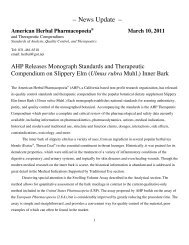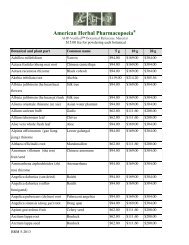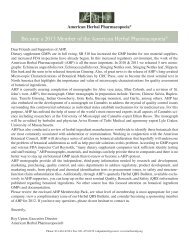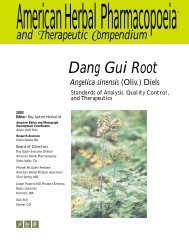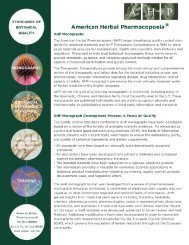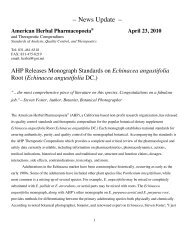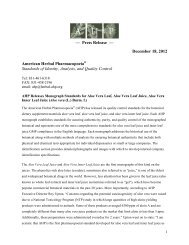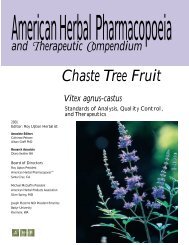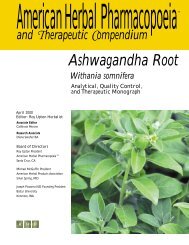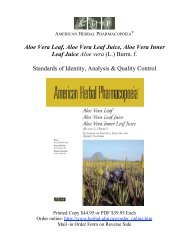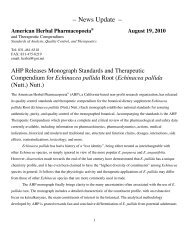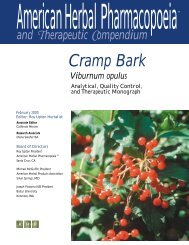alerian oot - American Herbal Pharmacopoeia
alerian oot - American Herbal Pharmacopoeia
alerian oot - American Herbal Pharmacopoeia
Create successful ePaper yourself
Turn your PDF publications into a flip-book with our unique Google optimized e-Paper software.
other symptoms, including cardiac palpitations, menopausal neurosis, and depression<br />
was observed. Side effects of gastrointestinal upset and headache were reported<br />
in only 8 patients (Seifert 1988). Similar results were reported in a study of 11,168<br />
patients treated by 982 German practitioners. Symptoms were eliminated in 70% of<br />
subjects, improved in another 24%, and only 6% of patients remained unchanged<br />
(Voight-Schmidt 1986). One final study compared the effects of two v<strong>alerian</strong> preparations<br />
(equivalent to 4 g) and flunitrazepam with placebo. All three medications<br />
were superior to placebo. However, less side effects were observed with the v<strong>alerian</strong><br />
preparations (10% of subjects) as compared to the group taking flunitrazepam (50%<br />
of subjects) (Gerhard and others 1996).<br />
In summary, the studies above have demonstrated statistically significant<br />
decreases in sleep latency and increases in sleep quality for poor sleepers. No change<br />
was reported in night awakenings, dream recall, total sleep time, or the normal levels<br />
of movement during the night.<br />
Numerous other studies on the effects of v<strong>alerian</strong> on sleep have been conducted<br />
with commercial products containing various adjuncts, particularly lemon balm<br />
(Melissa officinalis) and passion flower (Passiflora spp.). The results of these studies<br />
have shown these preparations to have a significant positive effect on sleep disorders,<br />
but have not been reviewed here.<br />
The effects of v<strong>alerian</strong> extract on stress were evaluated in a double-blind study<br />
using healthy volunteers. Forty-eight men and women were divided into four treatment<br />
groups receiving either placebo, 100 mg v<strong>alerian</strong> extract, 20 mg propranolol, or<br />
a combination of v<strong>alerian</strong> and propranolol (Kohnen and Oswald 1988). V<strong>alerian</strong> had<br />
no effect on stress-induced increases in heart rate caused by performing mathematical<br />
calculations verbally, although the propranolol and combination treatment<br />
reduced this physiological activation. V<strong>alerian</strong> treatment induced a slight improvement<br />
in a written concentration test, although there was a trend towards impairment<br />
of performance with the v<strong>alerian</strong>-propranolol combination. Both v<strong>alerian</strong> and the<br />
combination therapy led to less intense subjective feelings of “somatic arousal”.<br />
Animal Studies<br />
The essential oil of v<strong>alerian</strong> and the isolated components valerenal, valerenic acid,<br />
valeranone, and isoeugenyl-isovalerate were screened for central nervous system<br />
effects on mice upon ip administration (Hendriks and others 1985). The essential oil<br />
showed sedative and/or muscle relaxant activity with the oxygenated components<br />
exhibiting more activity than the hydrocarbon fraction. Valerenal and valerenic acid<br />
were more active than valeranone, producing ataxia at 50 mg/kg. Isoeugenyl-isovalerate<br />
did not appear to contribute much to the activity of the oil. In a subsequent<br />
study on valerenic acid, the authors reported a decrease in rotorod and traction performance<br />
in mice given 100 mg/kg ip. Valerenic acid also produced a dose-related<br />
increase in pentobarbital-induced sleep with 50 and 100 mg/kg ip (Hendriks and others<br />
1985). As a result of these tests, the authors described the activity of valerenic acid<br />
as a general central depressant rather than a neuroleptic or muscle relaxant.<br />
The antispasmodic effects of the isolated essential oil component valeranone and<br />
valepotriates (isovaltrate, valtrate, and didrovaltrate) were demonstrated in a series of<br />
in vivo and in vitro studies using guinea pig sm<strong>oot</strong>h muscle tissue (Hazelhoff and others<br />
1982). The above compounds at 20 mg/kg iv decreased rhythmic contractions and<br />
contractile force in ligated guinea pig ileum. In vitro studies using ileum and stomach<br />
tissue showed that the effects of valeranone and didrovaltrate (10 -5 to 10 -4 M) were<br />
not mediated through receptors of the cholinergic or adrenergic nervous system, but<br />
rather demonstrated a direct effect on the muscle tissue. The authors considered the<br />
activity to be similar to that of papaverine and suggested an effect on calcium levels<br />
in the muscle tissue.<br />
Comparison of the activity of v<strong>alerian</strong> extracts in mice all but eliminated the theory<br />
that valepotriates are responsible for the sedative activity. Nepalese and Chinese<br />
v<strong>alerian</strong> extracts containing 1.7% and 1.4% valepotriates, respectively, showed no<br />
sedative activity in mice after oral administration of the equivalent of 10 g crude<br />
drug/kg. However, Japanese v<strong>alerian</strong> r<strong>oot</strong> Hokkai kesso, containing 0.05% valepotriates,<br />
almost doubled hexobarbital-induced sleep (P < 0.01) and approximately halved<br />
<strong>American</strong> <strong>Herbal</strong> <strong>Pharmacopoeia</strong> • V<strong>alerian</strong> R<strong>oot</strong> • April 1999 Page 15



